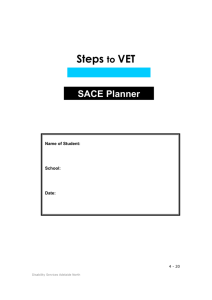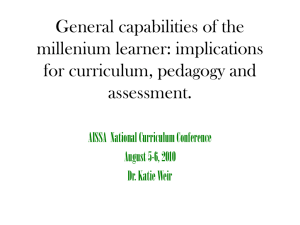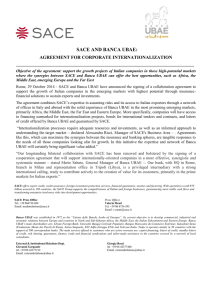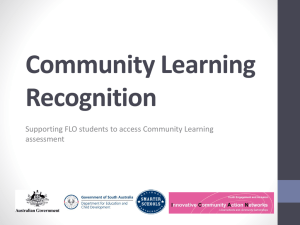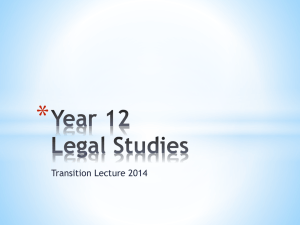Curriculum Assessment 10
advertisement
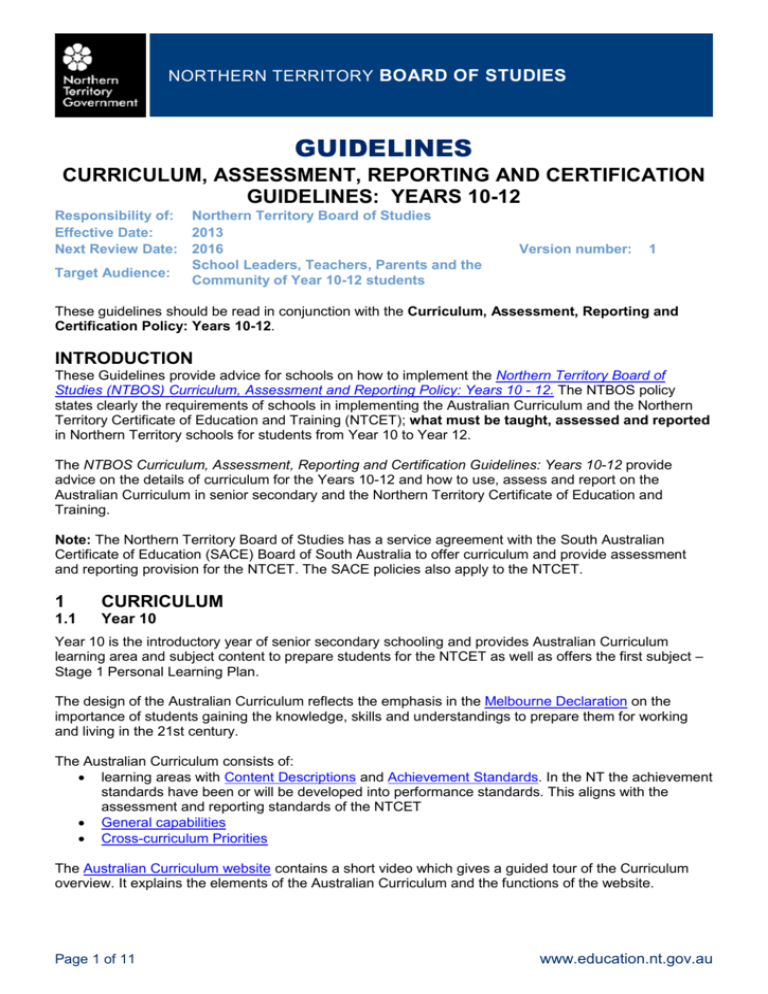
NORTHERN TERRITORY BOARD OF STUDIES GUIDELINES CURRICULUM, ASSESSMENT, REPORTING AND CERTIFICATION GUIDELINES: YEARS 10-12 Responsibility of: Northern Territory Board of Studies Effective Date: 2013 Next Review Date: 2016 School Leaders, Teachers, Parents and the Target Audience: Community of Year 10-12 students Version number: 1 These guidelines should be read in conjunction with the Curriculum, Assessment, Reporting and Certification Policy: Years 10-12. INTRODUCTION These Guidelines provide advice for schools on how to implement the Northern Territory Board of Studies (NTBOS) Curriculum, Assessment and Reporting Policy: Years 10 - 12. The NTBOS policy states clearly the requirements of schools in implementing the Australian Curriculum and the Northern Territory Certificate of Education and Training (NTCET); what must be taught, assessed and reported in Northern Territory schools for students from Year 10 to Year 12. The NTBOS Curriculum, Assessment, Reporting and Certification Guidelines: Years 10-12 provide advice on the details of curriculum for the Years 10-12 and how to use, assess and report on the Australian Curriculum in senior secondary and the Northern Territory Certificate of Education and Training. Note: The Northern Territory Board of Studies has a service agreement with the South Australian Certificate of Education (SACE) Board of South Australia to offer curriculum and provide assessment and reporting provision for the NTCET. The SACE policies also apply to the NTCET. 1 CURRICULUM 1.1 Year 10 Year 10 is the introductory year of senior secondary schooling and provides Australian Curriculum learning area and subject content to prepare students for the NTCET as well as offers the first subject – Stage 1 Personal Learning Plan. The design of the Australian Curriculum reflects the emphasis in the Melbourne Declaration on the importance of students gaining the knowledge, skills and understandings to prepare them for working and living in the 21st century. The Australian Curriculum consists of: learning areas with Content Descriptions and Achievement Standards. In the NT the achievement standards have been or will be developed into performance standards. This aligns with the assessment and reporting standards of the NTCET General capabilities Cross-curriculum Priorities The Australian Curriculum website contains a short video which gives a guided tour of the Curriculum overview. It explains the elements of the Australian Curriculum and the functions of the website. Page 1 of 11 www.education.nt.gov.au The website also contains short videos explaining the curriculum content of each learning area. A short video about digital resources that are linked to the Australian Curriculum is also available on the website. The Australian Curriculum is to be implemented in the following areas of learning as they are endorsed by ministers responsible for education each Australian jurisdiction. Implementation timelines are determined by the NTBOS. English and NT Year 10 Literacy Mathematics and NT Year 10 Numeracy Science History Health and Physical Education Until Australian Curriculum is developed and/or endorsed for implementation for all other learning areas and subjects, schools will offer the Northern Territory Curriculum Framework (NTCF) as optional subjects. 1.2 Northern Territory Certificate of Education and Training The Northern Territory Certificate of Education and Training (NTCET) qualification is designed to recognise the knowledge and skills acquired through formal school education and training. The completion requirements, approved by the NT Minister for Education, make the NTCET a unique and contemporary certificate with close alignment with senior secondary directions in other jurisdictions. Figure 1: The NTCET Pattern Page 2 of 11 www.education.nt.gov.au NTCET Completion Requirements Students must achieve an A, B or C grade for all the compulsory subjects (20 credits of Literacy, 10 credits of Numeracy, 10 credits of Personal Learning Plan and 60 credits of Stage 2 subjects) and courses Students must achieve an A, B or C grade in 140 credits Students must achieve at least 200 credits Recognised learning can be granted towards the certificate, this may include community developed programs, community learning or VET. The NTCET provides students with access to flexible learning arrangements where students have increased opportunities to develop the academic, interpersonal and employment-related skills needed for the future. The seven capabilities (Literacy, Numeracy, Information and Communication Technology Capability, Critical and Creative Thinking, Personal and Social Capability, Ethical Understanding and Intercultural Understanding) taught in each SACE/NTCET subject provide the basis for these skills1. The NTCET is based on the South Australian Certificate of Education (SACE). The SACE aims to provide a world-class senior secondary qualification signifying that each student possesses the knowledge, skills and capabilities to participate fully as informed citizens in their communities, the economy and society. The three central policies defining the SACE are the: SACE Accreditation, Recognition, and Certification Policy SACE Learning and Assessment Design Policy SACE Assuring Assessment Integrity Policy. Collectively, these SACE policies acknowledge the following: the SACE respects the diversity of students and their future pathways the SACE has rigorous standards the accreditation of SACE subjects is based on consistently applied learning and assessment principles student learning from the training sector, the community or providers other than the SACE Board, is appropriately recognised in the SACE the integrity of assessment in the SACE is assured the SACE is valued by the South Australian (and Northern Territory) communities and is recognised around the world (SACE Policy Framework, pg.1). Each of these statements is developed more fully in a set of principles which underpin the design and delivery of the SACE and, in the Northern Territory, the NTCET. There are completion requirement differences between the SACE and the NTCET. Students achieving a SACE are required to successfully complete the Stage 2 Research Project. There is a different requirement in the SACE on the number of credits of a C grade or higher. 1 The seven Australian Curriculum capabilities will replace the five SACE capabilities from 2014 onwards as subjects are updated. Page 3 of 11 www.education.nt.gov.au IMPLEMENTING THE CURRICULUM 1.3 Year 10 Support and planning documents are available for Year 10 Australian Curriculum on www.ntcet.net. These documents include: learning and assessment plan templates scope and sequence planning documents subject specific performance standards. Where a student cannot meet either the Year 10 English and/or Mathematics achievement standards, course advice is provided during Year 10 subject selection. Year 10 NT Literacy and/or Numeracy programs may be offered which cater for the student’s needs and move them towards Year 10 achievement. Alternative performance standards are applied to provide a grade for each student. Reports are provided which reflect the student’s grade and provide a comment that the student has not been graded using Year 10 achievement standards. Further support is provided on www.ntcet.net in regards to suggested pathways for these subjects. Stage 1 Personal Learning Plan This is a SACE developed subject that is usually studied in Year 10 and is recognised in the NTCET. The SACE Board has developed a Personal Learning Plan minisite that provides detailed advice and support for teachers. Prior to consideration of offering NTCET subjects to Year 10 students, extensive consultation with parents and students must occur. Enrolment in NTCET subjects should be linked to each student’s personal learning plan. 1.4 Years 11 and 12 (Stage 1 and 2): NTCET Curriculum Students who have begun their senior years of study interstate or overseas can apply for recognition of their learning towards the NTCET through the NT Curriculum, Assessment and Certification 10-12 Team. Subject Outlines Information about SACE subjects and their implementation are available on the subject page of the SACE website. Teachers can download subject outlines and a range of support materials. Subject outlines are available in the key materials section on each individual subject page. Subject outlines are documents that describe the learning and assessment requirements of a particular subject. Each subject outline includes sections that describe the following elements: capabilities learning scope and requirements assessment scope and requirements evidence of learning (organised in assessment types) assessment design criteria performance standards additional subject specific materials. Support materials are also available on each subject page. Page 4 of 11 www.education.nt.gov.au They can include: Learning and Assessment Plans - advice, exemplars and templates (see Planning) assessment tasks and annotated student responses subject advice and strategies for teachers. 1.5 Time allocations Year 10 Minimum Hours Per Year Compulsory Subjects 60 hours 120 hours (12%)** 120 hours (12%) 120 hours (12%) 80 hours (8%) 50 hours (5%) Stage 1 PLP* English or NT Year 10 Literacy Mathematics or NT Year 10 Numeracy Science Health and PE History* * some subjects do not necessarily need to be studied over the course of the whole year ** indicative percentage of face to face teaching and learning time Minimum Hours Per Year 50 hours 50 hours 20 hours Elective Economics Civics and Subjects Geography and Business Citizenship 80 hours The Arts 80 hours Technologies Languages Work Studies VET Other Stage 1 and 2 A 10 credit subject usually consists of approximately 60 hours of programmed teaching and learning time. It is generally considered to be a one semester or half year subject. A 20 credit subject usually consists of approximately 120 hours of programmed teaching and learning time. It is generally considered to be a full-year subject. 2 PEDAGOGY Intentionally designing pedagogical practice, so that all students will achieve learning outcomes lies at the heart of a professional educator’s repertoire of knowledge and skill in today’s education systems (Smith and Lynch, 2006). Designing for learning has progressed from a ‘teacher centred planning activity’ where syllabi and associated curriculum guidelines provided teachers with static content to be covered. Instead teachers design back from what is expected in the performance standards or Year 10 achievement standards. Teachers choose evidence based pedagogical strategies that can close the gap between where the student is now and where they are expected to be against the standards. Learning management questions The Eight Learning Management Questions (Smith and Lynch, 2006) are a set of sequential design questions that support teachers to design back from performance and achievement standards. At the heart of this design process is the learner and the expected standards they will achieve. It is expected that teachers will use this process to intentionally design instructional strategies and learning activities for students to achieve the highest possible standard. Page 5 of 11 www.education.nt.gov.au Examples of how the Learning Management Questions can be used with the NTCET can be found on the www.ntcet.net. 3 ASSESSMENT Assessment is an ongoing process within the teaching and learning cycle where teachers gather and record the evidence of learning that demonstrate what each student knows, understands and can do. Assessment involves developing, implementing, judging and providing feedback on student learning. Teachers plan, implement and gather representative samples of student learning: 3.1 throughout the learning experience (formative assessment) at the end of each major learning experience and/or at the end of each term and/or each semester (summative assessment). Assessment Processes Year 10 In the Northern Territory, Year 10 is seen as a foundation to the senior years. To prepare Year 10 students and their teachers for the assessment processes they will encounter in the senior years, assessment processes in Year 10 are designed to mirror those used in Stage 1 (Year 11) and Stage 2 (Year 12) subjects. As the Australian Curriculum is developed for each learning area, performance standards have and will be developed that describe five levels of achievement from A to E based on the achievement standards in the Australian Curriculum. Teachers will use performance standards and/or achievement standards to inform learning design, assessment and reporting. Stage 1 and 2 Assessment of student work in the SACE is underpinned by the use of performance standards. These standards – provided in each subject outline – describe in detail the level of achievement required to achieve each grade: from A to E for Stage 1 from A+ to E- for Stage 2. Teachers and assessors use these standards to decide how well a student has demonstrated his or her learning. The SACE Board quality assurance process is followed for all Stage 1 and 2 subjects (see 5.4). All Stage 2 subjects have a 30 per cent external assessment component and a 70 per cent moderated school assessment component. Modified subjects are graded as ‘completed’ or ‘not completed’. 3.2 NTCF Achievement Standards – Year 10 Until Australian Curriculum is developed for the remaining learning areas, teachers will: assess student achievement against the Learning Area Achievement Standards for the Northern Territory use the Assessment Design Guidelines, to design a range of valid assessment tasks. use the NT A – E Descriptors when assessing evidence of learning and for reporting to parents. Teachers will determine an A to E grade that shows the depth and breadth of learning against the student’s current year level achievement standard. Page 6 of 11 www.education.nt.gov.au 3.3 Performance Standards for Year 10 Australian Curriculum and NTCET subjects Each Australian Curriculum Year 10 and NTCET subject has a set of performance standards which describe in detail five levels of achievement from A to E. Teachers use these performance standards to decide how well a student has demonstrated his or her learning. Each grade corresponds with a level of the performance standards. Performance standards are more than a tool for assigning grades — they also offer opportunities for teachers and students to improve the quality of their teaching and learning. Teachers refer to the performance standards to: show each student what is required to be successful in his or her learning design assessment tasks that help students to demonstrate their learning at the highest possible level of achievement make decisions about the quality of the learning. Students can also refer to the performance standards to: show their learning in ways most appropriate to them monitor their progress understand what is expected at the end of a learning program (SACE Board: 2012). 3.4 Assessment Design Criteria Each NTCET subject has a specific set of assessment design criteria detailed in the subject outline. The assessment design criteria are based on the learning requirements and are used to: clarify for the student what he or she needs to learn design opportunities for the student to provide evidence of his or her learning at the highest possible level of achievement. The assessment design criteria consist of specific features that: students should demonstrate in their learning teachers look for as evidence that students have met the learning requirements (SACE Board, 2012). Each learning and assessment plan provides assessment design criteria and explains the relationship to the task and how it is assessed. 3.5 Quality Assurance Process for Assessment The assessment process is aligned with the SACE Quality Assurance Process for Assessment. There are four phases in the quality assurance cycle - planning, clarifying, confirming, and improving. The Quality Assurance process assures the integrity of the assessment and reporting of student achievement in the NTCET. The utilisation of this process assures the community that assessment integrity and assessment of learning in the NTCET is fair, valid and reliable. Specific information for Year 10, Stage 1 and Stage 2 assessment is provided on www.ntcet.net 1. Planning In the planning phase, teaching, learning and assessment opportunities are devised to enable students to demonstrate their learning against all aspects and levels of the performance standards. Teachers prepare a teaching and learning program and develop a learning and assessment plan. Page 7 of 11 www.education.nt.gov.au 2. Clarifying In the clarifying phase, teachers and assessors gain an understanding of the performance standards and apply them consistently to student work. 3. Confirming In the confirming phase, the performance standards in each subject are applied consistently across schools. 4. Improving In the improving phase, school and NTCET quality assurance processes are monitored and analysed to develop improvement strategies. 4 REPORTING Reporting is where teachers, schools and/or the SACE Board report to students, parents/carers and schools on how well the student has achieved against the performance standards in each subject. Reports also provide details of the student’s satisfactory completion of Vocational Education and Training (VET) training programs and other recognised or accredited courses. Teachers should use the subject specific performance standard for reporting to parents/carers. Until all Australian Curriculum learning areas/subjects are developed for Year 10, teachers should use the NT A to E Descriptors to guide them in reporting to parents/carers. VET is competency based learning that is nationally accredited by the Australian Skills Quality Authority (ASQA). A registered training organisation delivers and assesses the VET competencies. VET is recognised within the NTCET. The SACE ‘Recognition of VET in the SACE Policy’ provides additional information. Students receive a Statement of Attainment when they complete a VET qualification. Recorded VET qualifications can also be provided on a student’s NTCET Record of Achievement. 4.1 Frequency of reporting Schools must provide at least one written report each semester for all students for each subject studied. Each semester, the report will reflect student achievement demonstrated against the specific parts of the performance/achievement standard that have been taught to that point in time. Schools must provide at least one opportunity for a parent teacher interview at least each year. Schools are encouraged to provide other informal written and/or oral reports to parents/carers. In these reports, schools can comment on student learning growth and progress towards the achievement standard. This communication can take many forms including: teacher comments, portfolios of work, digital portfolios, films of students’ learning, oral presentations by students, parent/teachers/student conferences and telephone interviews. 4.2 Year 10 Reporting At the end of each semester, grades are provided for each subject taught using subject specific performance standards/achievement standards. Where students undertake NT Year 10 Literacy or Numeracy, grades will be assigned utilising the performance standards of NT Year 10 Literacy and NT Year 10 Numeracy. These are not necessarily aligned to the Year 10 Australian Curriculum achievement standards. A statement will be added to the student’s report stating that the grade has not been assessed against the Year 10 Australian Curriculum achievement standards. A Record of Achievement is provided to Year 10 (if enrolled in an NTCET subject) and Stage 1 students in August and the following February. Page 8 of 11 www.education.nt.gov.au 4.3 Stage 1 Reporting At the end of each semester, grades for all subjects are entered by schools into DATEX for reporting purposes. They can also be used by the school for reporting purposes. Once quality assurance processes are completed, the SACE Board will send each NTCET student a Record of Achievement in August and February which: lists all completed enrolments with a grade of E or better at Stage 1 shows the credit value for each completed enrolment lists granted recognition of VET and other recognised courses does not list withdrawn or deleted enrolments. Schools will provide a written report recording the student grade and a teacher comment which addresses the descriptors in the performance standard. 4.4 Stage 2 Reporting Subject grades are reported on the student’s SACE Record of Achievement. Listed are: all completed enrolments with a grade of E- (minus) or above at Stage 2 all completed enrolments with a grade of E or above at Stage 1 the credit value for each completed enrolment granted recognition of VET and other recognised courses. Withdrawn or deleted enrolments are not reported. 4.5 Reporting for students with a disability For students with a disability and an Educational Adjustment Plan (EAP), teachers: • should record an appropriate comment for each learning area or general capability addressed in the Plan • are not required to allocate an A to E grade unless requested by parents in consultation with the class and special education teachers. Stage 1 and Stage 2 modified subjects are reported as either ‘completed’ or ‘not completed’. 5 CERTIFICATION Following the results release period (usually December) students who achieve an NTCET receive a results package. This package may include: An NTCET certificate – formal recognition that a student has completed all NTCET requirements A Record of Achievement – a detailed record that the NTBOS issues to NTCET students at the end of the year if they have received a grade in at least one Stage 2 subject A Tertiary Entrance Statement – provided by the South Australian Tertiary Admission Centre (SATAC), which provides the university aggregate and Australian Tertiary Admission Rank (ATAR). Further information on how a university aggregate and ATAR are calculated can be found on the SATAC website or in the SATAC Tertiary Entrance booklet. The NTCET Results Information Sheet also provides additional information. The NTBOS Results Release Policy provides information on what data/information is released and to whom. Page 9 of 11 www.education.nt.gov.au 6 STUDENT DIVERSITY The flexibility offered by the Australian Curriculum, the NTCF and NTCET enables teachers to plan rigorous, relevant and engaging learning and assessment experiences for all students. Teachers make flexible use of instructional processes and assessment strategies to ensure that all students are able to access and engage with the Australian Curriculum, NTCF and NTCET in ways that are rigorous, relevant and meaningful. The NTCET is designed to provide opportunities for students to personalise their learning pathways. Schools and/or teachers use the flexibility in the structure of the certificate to: require all students to develop a Personal Learning Plan in which they design a personalised learning pathway through the NTCET design teaching and learning programs that meet the interests and needs of students offer access to flexible learning opportunities that are recognised or can be accredited by the SACE Board to meet the learning needs of their student cohort. Students who display high levels of success in a given year level may be provided with access to Stage 1 or Stage 2 subjects if appropriate, for example, Year 10 students may have access to Stage 1 subjects or Year 11 students may have access to Stage 2 subjects. Conversations with parents/carers will occur prior to subject selection. 6.1 Teaching students with English as an Additional Language or Dialect The aims of the Australian Curriculum are ultimately the same for all students. However, EAL/D students are simultaneously learning a new language and the knowledge, understanding and skills of the Australian Curriculum learning areas through that new language. They require additional time and support, along with informed teaching that explicitly addresses their language needs and assessments that take into account their developing language proficiency. Teacher resources The Australian Curriculum, Assessment and Reporting Authority (ACARA) has developed a range of resources to support teachers as they develop teaching and learning programs for EAL/D students. It comprises several related publications. The English as an Additional Language or Dialect Teacher Resource provides an overview of the scope of EAL/D learning and an EAL/D learning progression that will help teachers to identify the English language learning behaviours of the EAL/D students in their classrooms. It is designed as support material, especially for the mainstream teacher who is not an EAL/D specialist. The NTCET provides a range of subjects designed to meet the language learning (including English as a Second Language) needs of students at different levels, consistent with the provision of languages agreed by the Australasian Curriculum, Assessment and Certification Authorities (ACACA). All students who want to enrol in Stage 1 ESL must apply for eligibility. Support materials have been developed in a number of subjects for teachers of Indigenous students. These materials include a specific Indigenous focus or perspective. 6.2 Teaching students with a disability While there is some variation around the different NT schooling sectors, education adjustment plans are widely used to document an education program that is relevant and meaningful to individual students with a disability. ‘Schools should continue to develop individual learning plans reflective of goals which can include academic aspirations such as English and mathematics, as well as learning goals which may be identified as more indicative of functional performance’ (ACARA, 2012). The NTCET provides a set of modified subjects which are designed to allow students with identified significant intellectual disabilities as defined under the Disability Discrimination Act 1992 and the Page 10 of 11 www.education.nt.gov.au Disability Standards for Education 2005, to demonstrate their learning in a range of challenging and achievable learning experiences. Modified subjects allow students to develop their capabilities and personal learning goals. Students learn how to identify, develop and achieve their personal learning goals in the context of the subject undertaken. Students are eligible to enrol in modified subjects if they have identified intellectual disabilities and will not be able to reach the performance standards in mainstream subjects because of their intellectual functioning and adaptive behaviour. A student’s achievement in a modified subject will be reported as ‘completed’, with the appropriate number of NTCET credits. The NTCET certificate will indicate that the student has achieved the NTCET using one or more modified subjects. 6.3 Flexible Delivery The flexibility offered by the Australian Curriculum, NTCF and the NTCET enables teachers to plan rigorous, relevant and engaging learning and assessment experiences. Schools can customise student learning through flexible delivery arrangements, to design accelerated programs to meet the needs of specific groups of students. Schools can also offer courses designed and delivered by outside providers such as universities which are accredited under the SACE Accreditation, Recognition and Certification Policy. 6.4 Special Provisions The SACE Board will provide students with appropriate, fair and reasonable variations when their capacity to participate in an assessment is adversely affected in a significant way by illness, impairment or personal circumstances. Special Provisions identify variations to curriculum and assessment for eligible students at Stage 1 and Stage 2 of the NTCET. They are available to eligible students for both school assessments and external assessments. 7 SUPPORTING DOCUMENTS NTCET webpage www.ntcet.net SACE Board of SA website sace.sa.edu.au NTCET Annual Calendar – lists dates of events Page 11 of 11 www.education.nt.gov.au


